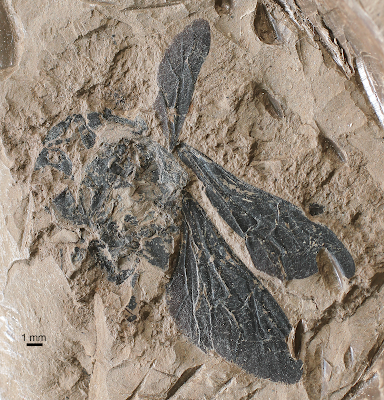Bumble Bees, Bombini, are one of the most familiar groups of Bees, Apidae, in temperate regions, being large, robust, solitary, social or parasitic Bees (the parasitic Bumble Bees are brood parasites, that lay their eggs in the nests of other Bee species, like Cuckoos) covered with dense fur, found on every continent except Africa and Australia. They are thought to have derived from their nearest ancestors in the Late Cretaceous, although all 263 described living species appear to have derived from a more recent common ancestor and are all placed in a single genus, Bombus, leaving a long stem lineage (i.e. Bees more closely related to modern Bumble Bees than they are to any other group of Bees, but less closely related to them than any living Bumble Bee is to any other living Bumble Bee). However the fossil record of Bumble Bees is somewhat sparse compared to other Bee groups, with two Late Eocene species known, from Teller County in Colorado and the Isle of Wight in England, and one Late Miocene specimen known from Catalonia, Spain, this last specimen being the oldest species assigned to the living genus Bombus.
In a paper published in the journal ZooKeys on 19 October 2017, Jakub Prokop of the Department of Zoology at Charles University, Manuel Dehon and Denis Michez of the Laboratory of Zoology at the University of Mons, and Michael Engel of the Division of Entomology at the Natural History Museum, and Department of Ecology & Evolutionary Biology of the University of Kansas and Division of Invertebrate Zoology at the American Museum of Natural History, describe a new species of Bumble Bee from the Early Eocene Most Formation of Teplice District in the Czech Republic.
The fossils of the Most Formation has been studies since the nineteenth century, and are noted for their high quality Plant and Insect fossils, with Ants being the most abundant group. The fossils occur in a lucastrine (lake derived) clay, laid down a subtropical to temperate climate.
The new species is placed within the genus Bombus, making it both the oldest known Bumble Bee and the oldest member of the crown group, and given the specific name trophonius, in reference to the Greek hero Trophonius, who died in a cave while hiding with stolen treasure, was lost and forgotten, and was rediscovered and worshipped as a demigod after a boy followed a trail of Bees to his final resting place. The species is described from a single female specimen, preserved as a black film, with a forewing length of 14.6 mm.
Photograph of Bombus trophonius, from the Early Miocene of Bílina Mine in northern Bohemia, Czech Republic. Prokop et al. (2017).
See also...
Follow Sciency Thoughts on Facebook.







